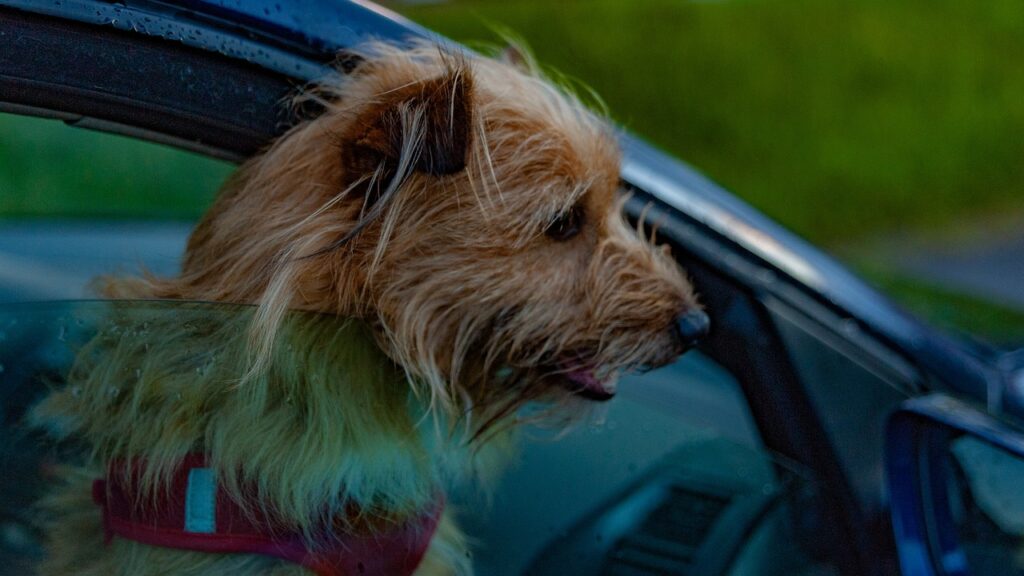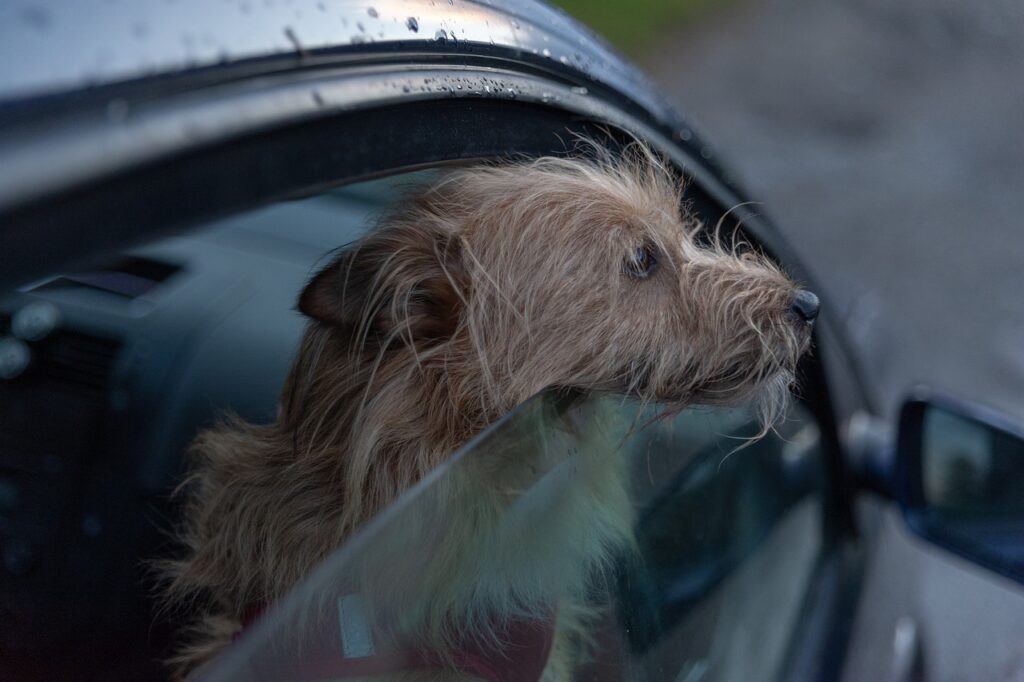Traveling with our furry friends can be a delightful experience. However, have you ever noticed that your dog starts panting excessively as soon as they hop in the car? This behavior can be quite concerning for dog owners.
In this article, we will explore the reasons why dogs pant in the car and provide you with some useful tips to help you alleviate this issue. Let’s dive in!
What is Panting?

Before we discuss why dogs pant in the car, let’s first understand what panting is. Panting is a normal behavior in dogs and is their way of regulating their body temperature.
Unlike humans, dogs do not sweat through their skin to cool down. Instead, they pant to exchange warm air from their lungs with cooler air from the environment, thus helping them cool off.
Why Dogs Pant in the Car – Reasons

Now that we know what panting is, let’s explore the reasons why dogs tend to pant excessively in the car:
1. Anxiety and Stress
Traveling in a car can sometimes make dogs feel anxious and stressed. Dogs are creatures of habit, and the unfamiliar environment of a moving vehicle can trigger anxiety. Panting is a common symptom of anxiety in dogs and serves as a coping mechanism.
2. Motion Sickness
Just like some humans, dogs can also experience motion sickness. The constant movement of the car can make their stomachs unsettled, leading to nausea and subsequent panting.
3. Fear of the Car
If your dog has had a negative experience in the car in the past, they may develop a fear or phobia associated with it. This fear can trigger panting as a response to the perceived threat.
4. Heat and Poor Ventilation
Cars can quickly become hot, especially during warm weather. Insufficient ventilation or leaving a dog in a parked car can cause the temperature to rise rapidly, leading to overheating. Panting helps dogs dissipate heat and regulate their body temperature.
5. Excitement

Dogs are naturally enthusiastic creatures, and the anticipation of going for a car ride can trigger excitement. Excitement-induced panting is often accompanied by wagging tails and a high energy level.
6. Lack of Conditioning
Some dogs may not be accustomed to car rides or have not been gradually conditioned to traveling in vehicles. This lack of conditioning can make them feel uneasy, resulting in panting.
7. Restricted Airflow
Certain car designs or restraints, such as crates or seat belts, can restrict a dog’s ability to move and position themselves comfortably. Limited airflow can contribute to panting.
8. Unfamiliar Sounds and Smells
The noises and odors associated with car travel, such as engine sounds or exhaust fumes, can be overwhelming for dogs. These unfamiliar stimuli can trigger anxiety and panting.
9. Lack of Restraint or Security
Dogs may feel insecure or unsafe if they are not properly restrained or secured in the car. This feeling of instability can lead to panting.
10. Car Sickness Medications

Some dogs are prescribed medications to help alleviate car sickness. These medications can have side effects, including increased panting.
11. Breed Characteristics
Certain dog breeds are more prone to panting due to their physical characteristics. Brachycephalic breeds, such as Bulldogs or Pugs, have shorter muzzles, which can make it harder for them to breathe efficiently.
As a result, they may pant more frequently, especially in stressful situations like car rides.
12. Underlying Medical Conditions
In some cases, excessive panting in the car could be a sign of an underlying medical condition. If you notice persistent panting, it is essential to consult with your veterinarian to rule out any potential health issues.
How to Stop Dogs from Panting in the Car

Now that we understand the reasons why dogs pant in the car, let’s explore some effective strategies to help alleviate this behavior:
1. Gradual Desensitization
Gradual desensitization is the process of exposing your dog to the car in a positive and gradual manner. Start by allowing your dog to explore the stationary car with treats and praise.
Once they are comfortable, progress to short drives around the block, gradually increasing the duration. This process helps them associate the car with positive experiences and reduces anxiety.
2. Comfortable Restraints
Ensure your dog is properly restrained and secured during car rides. This can be achieved using seat belts, car harnesses, or crates. Providing a secure and comfortable environment will help your dog feel safer and reduce panting.
3. Sufficient Ventilation
Ensure that the car has proper ventilation by opening windows or using air conditioning. This will help maintain a comfortable temperature and fresh air flow, reducing the likelihood of overheating and excessive panting.
4. Familiar Smells and Sounds
Introduce familiar scents and sounds to your dog’s car environment. Placing their favorite blanket or toy inside the car can provide a sense of familiarity and comfort, reducing anxiety and panting.
5. Breaks and Hydration

During long car journeys, make frequent stops to allow your dog to stretch their legs, relieve themselves, and have access to fresh water. Staying hydrated and taking breaks can help alleviate discomfort and reduce panting.
6. Avoid Feeding Before Travel
Feeding your dog a large meal before a car ride can increase the chances of motion sickness. Avoid feeding them a full meal right before traveling to minimize the risk of nausea-induced panting.
7. Calming Aids
Consult with your veterinarian about the use of natural calming aids or medications that can help reduce anxiety and motion sickness in your dog. These aids can be beneficial for dogs that struggle with car-related stress and panting.
8. Professional Training
If your dog’s panting in the car persists despite your best efforts, seeking the help of a professional dog trainer or behaviorist may be beneficial. They can provide specialized training techniques and guidance tailored to your dog’s specific needs.
Read More: Why Does My Dog Cry At Night?
Frequently Asked Questions (FAQs)
Q1: Is it normal for dogs to pant in the car?
Yes, it is normal for dogs to pant in the car, especially if they are experiencing anxiety, motion sickness, or high temperatures. However, excessive panting or panting accompanied by other concerning symptoms should be evaluated by a veterinarian.
Q2: How can I tell if my dog is panting due to anxiety?
Anxious panting is often accompanied by other signs of stress, such as pacing, drooling, trembling, or restlessness. If your dog exhibits these behaviors in the car, it is likely due to anxiety.
Q3: Can I give my dog medication to stop car sickness-induced panting?
Consult with your veterinarian before giving any medication to your dog. They can recommend appropriate medications or natural remedies to help alleviate car sickness and associated panting.
Q4: My dog is a brachycephalic breed. Should I be worried about their panting in the car?
Brachycephalic breeds are more prone to respiratory difficulties, so it is essential to monitor their panting carefully. If you notice any signs of distress, consult with your veterinarian for guidance.
Q5: What should I do if my dog’s panting in the car is persistent or worsens?
If your dog’s panting in the car persists or worsens, it is recommended to seek professional advice from a veterinarian. They can conduct a thorough examination and identify any underlying medical or behavioral issues.
Conclusion
Dogs pant in the car for various reasons, including anxiety, motion sickness, fear, and high temperatures. Understanding the underlying causes and implementing appropriate strategies can help alleviate this behavior and ensure a more enjoyable travel experience for both you and your furry friend.
By following the tips provided in this article, you can create a safer and more comfortable car environment for your dog. Remember, if you have any concerns about your dog’s panting, it is always best to consult with a veterinarian for personalized guidance. Happy travels!

